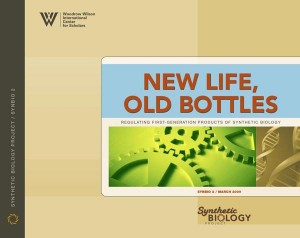A new report looks at the challenges of regulating first generation products of synthetic biology.
At the J. Craig Venter Institute, scientists are on the verge of creating a living organism from “dead” chemicals, by rebooting a microbe with a new—and completely artificially constructed—genome.
At the University of California Berkeley, researchers are modifying microbes to act as highly efficient chemical plants, by rewriting their DNA.
In Cambridge Massachusetts, amateur biologists are scoring cheap laboratory equipment off eBay and Craigs List, and constructing their own designer bugs.
While all over the world, hundreds of enthusiastic undergraduates are competing to systematically design and build new DNA-based biological systems and get them operating in living cells.
Synthetic biology—the systematic engineering of biological organisms from the DNA up—is a reality now, and is destined to grow into an incredibly powerful transformative technology over the next few years.
But can we handle it?
In amidst the many questions our accelerating ability to manipulate DNA raises is one of oversight: Are government agencies equipped to ensure the safety of new synthetic biology-related products and processes?
A new report by Mike Rodemeyer—formerly Executive Director of the Pew Initiative on Food and Biotechnology—addresses exactly this question. Commissioned by the Woodrow Wilson Center in Washington DC, New life, old bottles takes a critical look at regulating the first-generation products of synthetic biology.
Perhaps not surprisingly, Rodemeyer concludes that once you peer under the hood (so to speak), there’s not a lot from a regulatory perspective that differentiates first generation synthetic biology from more traditional recombinant DNA (rDNA)-based technology. Which means that where things work for rDNA, they look pretty good for synbio.
Of course, this also means that where oversight of traditional biotech is flaky, things aren’t likely to be any easier for synthetic biology.
However, the report also suggests that synthetic biology may have the potential to stretch an already stressed system to breaking point at some point in the future. As it is, traditional biotechnology was shoehorned into a regulatory system within the US that was developed long before the practical consequences of DNA manipulation were understood. As a result (for example), genetically engineered organisms are currently regulated as new chemical substances by the Environmental Protection Agency.
Just in case you didn’t catch that: in simple terms, the DNA within a genetically modified organism is legally considered to be a new chemical, and thus is regulated as such. An elegant solution to fitting new technology into old rules, but one that may find run out of steam rather rapidly as synthetic biology hits its stride.
And the current regulatory framework doesn’t even begin to touch on developments that lie outside its traditional sphere of control—including a growing “biohacking” community.
Rodemeyer’s piece is more about setting out the issues and posing questions than providing solutions. And it does this extremely well. If you want aan excellent description of what synthetic biology is all about, the regulatory framework within which it is developing, or the challenges it presents to that framework, this is the report to read. It’s clear, it’s accessible, and it’s highly readable.
But if you insist on an overarching take-home message, it would be this (and these are my words, not his):
We are on the brink of a revolution in biotechnology that will make old biotech look like the fumblings of a toddler. And while we may have got away with squeezing new tech into old regulatory bottles in the past, this approach isn’t going to work for much longer! Rather, if synthetic biology is to grow into a mature, safe and accepted technology, some regulatory rethinking will be needed.
The old bottles, it seems, will last us a little longer. But at some point they are going to burst at the seams. And what then, if we don’t have bigger, better, more flexible containers handy?

